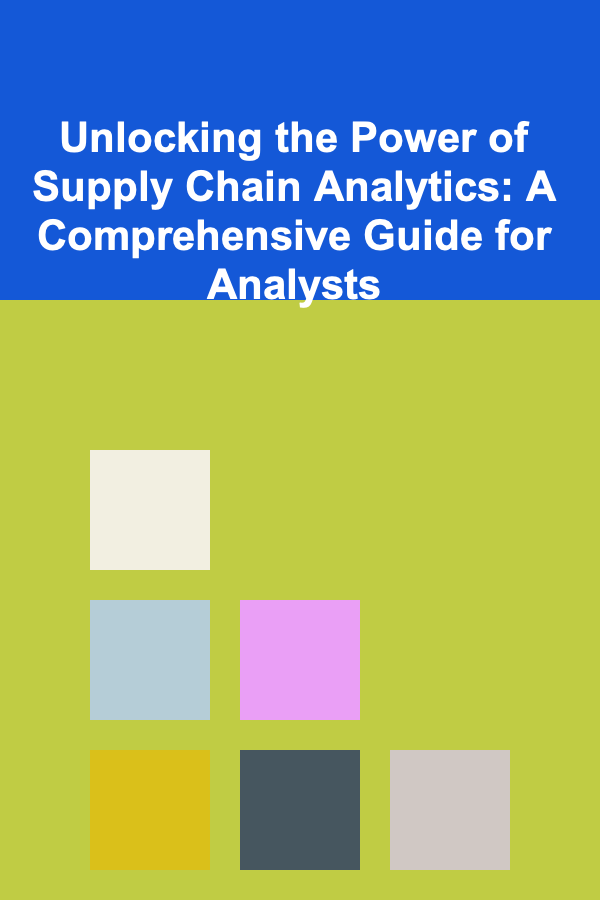
10 Tips for Analyzing Qualitative Data in UX Research
ebook include PDF & Audio bundle (Micro Guide)
$12.99$8.99
Limited Time Offer! Order within the next:
Not available at this time

In User Experience (UX) research, the primary objective is to understand users' behaviors, needs, motivations, and experiences to improve product design. Unlike quantitative data, which is numerical and typically involves statistical analysis, qualitative data focuses on non-numerical insights, often derived from interviews, observations, surveys, and user feedback. Qualitative data in UX research provides deeper, richer insights into how users interact with products and what they feel and think about them.
However, analyzing qualitative data effectively can be a daunting task, especially given its complexity and subjective nature. But with the right strategies, UX researchers can extract meaningful insights that will shape and enhance the user experience. In this article, we'll explore 10 essential tips to guide you through the process of analyzing qualitative data in UX research, from gathering data to synthesizing and presenting your findings.
Define Clear Research Goals Before Starting
Before diving into the process of data collection and analysis, it is vital to establish clear and specific research goals. Knowing what you hope to achieve through your UX research will help guide your analysis and ensure you focus on the right aspects of the data.
- Why are you conducting the research? Are you trying to uncover pain points, explore user satisfaction, or identify areas for design improvement?
- What questions are you aiming to answer? Develop a set of guiding questions based on your goals to keep your analysis focused and relevant.
- Who are your users? Understanding your user persona or target audience will help you identify the themes and insights most pertinent to your analysis.
Having well-defined research goals will not only provide direction during data collection but will also simplify the subsequent analysis phase by narrowing down the most relevant data points.
Organize Your Data Methodically
Once you have gathered qualitative data through interviews, usability tests, or surveys, organizing it is crucial for effective analysis. A disorganized dataset can be overwhelming and difficult to interpret.
Key Strategies for Organizing Data:
- Transcribe interviews and recordings: Make sure all interviews, focus groups, and other qualitative data are accurately transcribed. This allows you to analyze the information more effectively and helps avoid the risk of missing out on critical user insights.
- Create a coding system: Develop a system to organize your data into specific categories, such as user behaviors, frustrations, goals, and suggestions. A simple spreadsheet or tool like Airtable can help you classify and tag your data for easier access during the analysis process.
- Group data by themes: After transcription, group similar data points together. This will help you identify trends and patterns and make the analysis process more systematic.
Organizing your data in a structured way will streamline the analysis process and ensure that you don't overlook valuable insights.
Use Open Coding to Identify Key Themes
In qualitative research, coding is the process of categorizing and labeling data to make it easier to analyze. Open coding, a technique used in grounded theory, is one of the most effective methods for analyzing qualitative data in UX research. It involves going through your data line-by-line and identifying initial themes or patterns.
Steps for Open Coding:
- Read through the data carefully: As you go through the data, identify important pieces of information that relate to your research questions.
- Label key concepts: Assign labels (codes) to these pieces of data. These labels should represent the main ideas, emotions, or behaviors expressed by users. For example, if users express frustration with navigation, you could label this as "navigation issues."
- Refine your codes: Over time, you might discover that some codes can be combined, while others need further clarification. Continuously refine your codes as you proceed.
Open coding provides a framework for organizing your data and developing a deeper understanding of the user experience.
Use Thematic Analysis to Synthesize Data
Once you've identified and labeled key codes from your open coding process, the next step is to perform thematic analysis. Thematic analysis is a method for identifying, analyzing, and reporting patterns or themes within your data. This allows you to draw meaningful conclusions about users' needs and behaviors.
Steps for Conducting Thematic Analysis:
- Identify major themes: Review your coded data and identify larger themes that emerge. For example, if several users mention difficulty with task completion, you might identify a theme such as "task flow issues."
- Group related codes: Combine smaller, related codes into larger themes that reflect broader concepts. For example, "usability problems," "navigation issues," and "task completion" could all fall under a broader theme like "usability concerns."
- Refine your themes: Continuously revisit your themes and adjust as needed. You may need to break up large themes into sub-themes or combine related themes as you analyze the data further.
Thematic analysis allows you to take the raw data and structure it in a way that reveals the deeper insights and patterns that are crucial for design decisions.
Prioritize Insights Based on Impact
After identifying the key themes from your data, it's important to prioritize which insights will have the most significant impact on the user experience and product design. Not all insights will have the same level of importance or urgency, so focusing on the most critical ones will help drive meaningful improvements.
Strategies for Prioritizing Insights:
- Align with business objectives: Look at how each insight aligns with the business goals and objectives. For example, if your product aims to increase user engagement, prioritize insights related to user retention or ease of use.
- Consider severity and frequency: Identify recurring issues or frustrations mentioned by multiple users. These are likely to have a more significant impact on the overall user experience.
- Balance quick wins with long-term improvements: Prioritize issues that can be resolved quickly for immediate user benefits, while also considering more complex problems that may take longer to solve but will lead to long-term improvements.
Prioritizing your insights ensures that the most impactful changes are made first, resulting in a better user experience.
Visualize Findings with Affinity Diagrams
Affinity diagrams are a useful tool for grouping and visualizing qualitative data. They allow you to visually organize insights into clusters, making it easier to identify connections and patterns between themes.
How to Create an Affinity Diagram:
- Write down key insights: Write each data point or insight on a sticky note (physical or digital).
- Group similar insights: Place similar insights or themes together in clusters. For example, all user frustrations about navigation might be grouped together.
- Label clusters: Once the insights are organized, label each group with a theme or category.
- Analyze the relationships: Use the diagram to see how different themes relate to each other and how they might inform design decisions.
Affinity diagrams provide a visual representation of the data that can help you make sense of large datasets and identify connections that may not be immediately obvious.
Use a Data-Driven Storytelling Approach
Effective communication is key when presenting your findings. Data-driven storytelling helps you convey your insights in a way that resonates with stakeholders, making your qualitative research findings more compelling and actionable.
How to Use Storytelling in UX Research:
- Develop user personas: Use your qualitative data to create user personas that represent typical users and their pain points. This helps stakeholders empathize with users.
- Craft narratives: Present your findings as stories that describe the challenges and experiences users face when interacting with the product.
- Include quotes: Incorporating direct quotes from users adds authenticity to your story and strengthens the emotional impact of your findings.
By using storytelling, you make your research more relatable and persuasive, which can lead to more effective design decisions.
Validate Findings Through Triangulation
While qualitative data provides rich insights, it can sometimes be subjective or influenced by biases. To ensure the validity of your findings, consider using triangulation. This involves cross-checking your qualitative data with other data sources, such as quantitative data, to corroborate your conclusions.
Methods for Triangulation:
- Compare with quantitative data: If you have access to quantitative metrics, such as usability test scores or survey results, compare these with your qualitative findings to validate the insights.
- Use multiple data collection methods: Combining interviews with surveys, user testing, and observational data can provide a more comprehensive understanding of the user experience.
- Consult with other researchers: Collaborate with other team members or researchers to validate your interpretation of the data and reduce potential biases.
Triangulation helps strengthen the reliability and credibility of your findings.
Use Tools and Software to Streamline Analysis
There are numerous tools and software options available to help UX researchers analyze qualitative data more efficiently. These tools can assist with everything from coding to theme identification and data visualization.
Popular Tools for Analyzing Qualitative Data:
- Dedoose: A web-based application that helps researchers analyze qualitative and mixed methods data.
- NVivo: A powerful tool for qualitative data analysis that provides advanced coding features and the ability to visualize data.
- Miro: A digital collaboration tool that allows you to create affinity diagrams and visualize data in real-time with your team.
Using the right tools can significantly streamline your analysis process and help you focus on uncovering valuable insights.
Continuously Reflect and Iterate
Finally, it's essential to continuously reflect on your analysis process and iterate as needed. UX research is an ongoing process, and your findings may evolve as new data is collected or as design changes are implemented.
Tips for Continuous Improvement:
- Document your process: Keep track of the steps you took during the analysis process. This documentation will help you improve your approach in future research projects.
- Seek feedback: Regularly ask for feedback from team members or stakeholders to ensure that your analysis is on track and that your findings are actionable.
- Iterate based on results: As new insights emerge, refine your analysis and recommendations. Stay flexible and adapt to the evolving needs of the research.
By continuously reflecting and iterating, you can improve the depth and accuracy of your analysis, leading to more effective and user-centered design decisions.
Conclusion
Analyzing qualitative data in UX research can be challenging, but it is a vital skill for uncovering the deep, nuanced insights that drive user-centered design. By following the tips outlined in this article, UX researchers can improve their ability to analyze data effectively, uncover meaningful patterns, and communicate their findings in a way that leads to actionable insights.
Whether you're organizing and coding your data, using thematic analysis to identify key trends, or leveraging tools for streamlining your process, the key to successful qualitative analysis is a combination of structured methods, thoughtful reflection, and collaboration. By continuously refining your approach, you can elevate your UX research and create products that truly resonate with users.

How to Create a Home Library with Smart Storage Solutions
Read More
How to Create a Simple Budgeting System for Your Home
Read More
How to Develop a Strong Personal Brand
Read More
How to Make the Most of Your Apartment Balcony
Read More
Unlocking the Power of Supply Chain Analytics: A Comprehensive Guide for Analysts
Read More
How to Choose a Credit Card with No Annual Fee
Read MoreOther Products

How to Create a Home Library with Smart Storage Solutions
Read More
How to Create a Simple Budgeting System for Your Home
Read More
How to Develop a Strong Personal Brand
Read More
How to Make the Most of Your Apartment Balcony
Read More
Unlocking the Power of Supply Chain Analytics: A Comprehensive Guide for Analysts
Read More